NiCoP/g-C3N4 Nanocomposites-Based Electrochemical Immunosensor for Sensitive Detection of Procalcitonin
Abstract
1. Introduction
2. Experiment Section
2.1. Materials
2.2. Instrumentations
2.3. Synthesis of g-C3N4 and NiCoP/g-C3N4 Nanocomposite
2.4. Carboxylation of NiCoP/g-C3N4 Nanocomposites (COOH-NiCoP/g-C3N4)
2.5. Preparation of PCT Biosensor
2.6. General Characterization
2.7. PCT Sensing in Tris-HCl
2.8. PCT Detection in Serum Sample
3. Results and Discussion
3.1. The Morphology and Structural Information
3.2. Characterization of Carboxylic NiCoP/g-C3N4 Nanocomposites
3.3. Biosensor Characterization
3.4. Detection Performance of the Electrochemical Immunosensor
3.5. Application for the Real Sample Analysis
4. Conclusions
Author Contributions
Funding
Institutional Review Board Statement
Informed Consent Statement
Data Availability Statement
Conflicts of Interest
References
- Fang, J.; Li, J.; Feng, R.; Yang, L.; Zhao, L.; Zhang, N.; Zhao, G.; Yue, Q.; Wei, Q.; Cao, W. Dual-quenching electrochemiluminescence system based on novel acceptor CoOOH@Au NPs for early detection of procalcitonin. Sens. Actuators B Chem. 2021, 332, 129544. [Google Scholar] [CrossRef]
- Fang, Y.S.; Wang, H.Y.; Wang, L.S.; Wang, J.F. Electrochemical immunoassay for procalcitonin antigen detection based on signal amplification strategy of multiple nanocomposites. Biosens. Bioelectron. 2014, 51, 310–316. [Google Scholar] [CrossRef] [PubMed]
- BalcI, C.; Sungurtekin, H.; Gürses, E.; Sungurtekin, U.; Kaptanoğlu, B.J. Usefulness of procalcitonin for diagnosis of sepsis in the intensive care unit. Crit. Care 2002, 7, 1–6. [Google Scholar] [CrossRef] [PubMed]
- Gendrel, D.; Assicot, M.; Raymond, J.; Moulin, F.; Francoual, C.; Badoual, J.; Bohuon, C. Procalcitonin as a marker for the early diagnosis of neonatal infection. J. Pediatr. 1996, 128, 570–573. [Google Scholar] [CrossRef] [PubMed]
- Schröder, J.; Staubach, K.-H.; Zabel, P.; Stüber, F.; Kremer, B. Procalcitonin as a marker of severity in septic shock. Langenbeck’s Arch. Surg. 1999, 384, 33–38. [Google Scholar] [CrossRef]
- Liao, T.; Yuan, F.; Yu, H.; Li, Z. An ultrasensitive ELISA method for the detection of procalcitonin based on magnetic beads and enzyme-antibody labeled gold nanoparticles. Anal. Methods 2016, 8, 1577–1585. [Google Scholar] [CrossRef]
- Chiang, C.Y.; Huang, T.T.; Wang, C.H.; Huang, C.J.; Tsai, T.H.; Yu, S.N.; Chen, Y.T.; Hong, S.W.; Hsu, C.W.; Chang, T.C.; et al. Fiber optic nanogold-linked immunosorbent assay for rapid detection of procalcitonin at femtomolar concentration level. Biosens. Bioelectron. 2020, 151, 111871. [Google Scholar] [CrossRef]
- Buchegger, P.; Preininger, C. Four assay designs and on-chip calibration: Gadgets for a sepsis protein array. Anal. Chem. 2014, 86, 3174–3180. [Google Scholar] [CrossRef]
- Buchegger, P.; Sauer, U.; Toth-Székély, H.; Preininger, C. Miniaturized Protein Microarray with Internal Calibration as Point-of-Care Device for Diagnosis of Neonatal Sepsis. Sensors 2012, 12, 1494–1508. [Google Scholar] [CrossRef]
- Marcello, A.; Sblattero, D.; Cioarec, C.; Maiuri, P.; Melpignano, P. A deep-blue OLED-based biochip for protein microarray fluorescence detection. Biosens. Bioelectron. 2013, 46, 44–47. [Google Scholar] [CrossRef]
- Li, H.; Sun, Y.; Elseviers, J.; Muyldermans, S.; Liu, S.; Wan, Y. A nanobody-based electrochemiluminescent immunosensor for sensitive detection of human procalcitonin. Analyst 2014, 139, 3718–3721. [Google Scholar] [CrossRef]
- Song, C.; Li, X.; Hu, L.; Shi, T.; Wu, D.; Ma, H.; Zhang, Y.; Fan, D.; Wei, Q.; Ju, H. Quench-type electrochemiluminescence immunosensor based on resonance energy transfer from carbon nanotubes and Au-nanoparticles-enhanced g-C3N4 to CuO@ Polydopamine for procalcitonin detection. ACS Appl. Mater. Interfaces 2020, 12, 8006–8015. [Google Scholar] [CrossRef]
- Shao, X.; Song, X.; Liu, X.; Yan, L.; Liu, L.; Fan, D.; Wei, Q.; Ju, H. A dual signal-amplified electrochemiluminescence immunosensor based on core-shell CeO2-Au@Pt nanosphere for procalcitonin detection. Microchim. Acta 2021, 188, 1–9. [Google Scholar] [CrossRef]
- Sener, G.; Ozgur, E.; Rad, A.Y.; Uzun, L.; Say, R.; Denizli, A. Rapid real-time detection of procalcitonin using a microcontact imprinted surface plasmon resonance biosensor. Analyst 2013, 138, 6422–6428. [Google Scholar] [CrossRef]
- Vashist, S.K.; Schneider, E.M.; Barth, E.; Luong, J.H.T. Surface plasmon resonance-based immunoassay for procalcitonin. Anal. Chim. Acta 2016, 938, 129–136. [Google Scholar] [CrossRef]
- Sun, L.L.; Leo, Y.S.; Zhou, X.; Ng, W.; Wong, T.I.; Deng, J. Localized surface plasmon resonance based point-of-care system for sepsis diagnosis. Mater. Sci. Energy Technol. 2020, 3, 274–281. [Google Scholar] [CrossRef]
- Ge, X.Y.; Zhang, J.X.; Feng, Y.G.; Wang, A.J.; Mei, L.P.; Feng, J.J. Label-free electrochemical biosensor for determination of procalcitonin based on graphene-wrapped Co nanoparticles encapsulated in carbon nanobrushes coupled with AuPtCu nanodendrites. Microchim. Acta 2022, 189, 1–13. [Google Scholar] [CrossRef]
- Gupta, Y.; Pandey, C.M.; Ghrera, A.S. Development of conducting cellulose paper for electrochemical sensing of procalcitonin. Microchim. Acta 2022, 190, 32. [Google Scholar] [CrossRef]
- De Oliveira, P.R.; Crapnell, R.D.; Ferrari, A.G.M.; Wuamprakhon, P.; Hurst, N.J.; Dempsey-Hibbert, N.C.; Sawangphruk, M.; Janegitz, B.C.; Banks, C.E. Low-cost, facile droplet modification of screen-printed arrays for internally validated electrochemical detection of serum procalcitonin. Biosens. Bioelectron. 2023, 228, 115220. [Google Scholar] [CrossRef]
- Chen, Y.X.; Wu, X.; Huang, K.J. A sandwich-type electrochemical biosensing platform for microRNA-21 detection using carbon sphere-MoS2 and catalyzed hairpin assembly for signal amplification. Sens. Actuators B Chem. 2018, 270, 179–186. [Google Scholar] [CrossRef]
- Wang, H.; Ma, Y.; Guo, C.; Yang, Y.; Peng, Z.; Liu, Z.; Zhang, Z. Templated seed-mediated derived Au nanoarchitectures embedded with nanochitosan: Sensitive electrochemical aptasensor for vascular endothelial growth factor and living MCF-7 cell detection. Appl. Surf. Sci. 2019, 481, 505–514. [Google Scholar] [CrossRef]
- Li, M.; He, B. Ultrasensitive sandwich-type electrochemical biosensor based on octahedral gold nanoparticles modified poly (ethylenimine) functionalized graphitic carbon nitride nanosheets for the determination of sulfamethazine. Sens. Actuators B Chem. 2021, 329, 129158. [Google Scholar] [CrossRef]
- Zhang, X.; Xie, X.; Wang, H.; Zhang, J.; Pan, B.; Xie, Y. Enhanced Photoresponsive Ultrathin Graphitic-Phase C3N4 Nanosheets for Bioimaging. J. Am. Chem. Soc. 2013, 135, 18–21. [Google Scholar] [CrossRef] [PubMed]
- Feng, Q.M.; Shen, Y.Z.; Li, M.X.; Zhang, Z.L.; Zhao, W.; Xu, J.J.; Chen, H.Y. Dual-Wavelength Electrochemiluminescence Ratiometry Based on Resonance Energy Transfer between Au Nanoparticles Functionalized g-C3N4 Nanosheet and Ru(bpy)3(2+) for microRNA Detection. Anal. Chem. 2016, 88, 937–944. [Google Scholar] [CrossRef]
- Wang, Y.Z.; Hao, N.; Feng, Q.M.; Shi, H.W.; Xu, J.J.; Chen, H.Y. A ratiometric electrochemiluminescence detection for cancer cells using g-C3N4 nanosheets and Ag-PAMAM-luminol nanocomposites. Biosens. Bioelectron. 2016, 77, 76–82. [Google Scholar] [CrossRef]
- Medetalibeyoglu, H.; Beytur, M.; Akyıldırım, O.; Atar, N.; Yola, M.L. Validated electrochemical immunosensor for ultra-sensitive procalcitonin detection: Carbon electrode modified with gold nanoparticles functionalized sulfur doped MXene as sensor platform and carboxylated graphitic carbon nitride as signal amplification. Sens. Actuators B Chem. 2020, 319, 128195. [Google Scholar] [CrossRef]
- Zou, J.; Wu, S.; Liu, Y.; Sun, Y.; Cao, Y.; Hsu, J.-P.; Shen Wee, A.T.; Jiang, J. An ultra-sensitive electrochemical sensor based on 2D g-C3N4/CuO nanocomposites for dopamine detection. Carbon 2018, 130, 652–663. [Google Scholar] [CrossRef]
- Lin, Y.; Pan, Y.; Liu, S.; Sun, K.; Cheng, Y.; Liu, M.; Wang, Z.; Li, X.; Zhang, J. Construction of multi-dimensional core/shell Ni/NiCoP nano-heterojunction for efficient electrocatalytic water splitting. Appl. Catal. B Environ. 2019, 259, 118039. [Google Scholar] [CrossRef]
- Li, J.; Yan, M.; Zhou, X.; Huang, Z.Q.; Xia, Z.; Chang, C.R.; Ma, Y.; Qu, Y. Mechanistic insights on ternary Ni2−xCoxP for hydrogen evolution and their hybrids with graphene as highly efficient and robust catalysts for overall water splitting. Adv. Funct. Mater. 2016, 26, 6785–6796. [Google Scholar] [CrossRef]
- Li, Y.; Liu, J.; Chen, C.; Zhang, X.; Chen, J. Preparation of NiCoP hollow quasi-polyhedra and their electrocatalytic properties for hydrogen evolution in alkaline solution. ACS Appl. Mater. Interfaces 2017, 9, 5982–5991. [Google Scholar] [CrossRef]
- Wang, Z.; Cao, X.; Liu, D.; Hao, S.; Du, G.; Asiri, A.M.; Sun, X. Ternary NiCoP nanosheet array on a Ti mesh: A high-performance electrochemical sensor for glucose detection. Chem. Commun. 2016, 52, 14438–14441. [Google Scholar] [CrossRef]
- Bi, L.; Gao, X.; Zhang, L.; Wang, D.; Zou, X.; Xie, T. Enhanced Photocatalytic Hydrogen Evolution of NiCoP/g-C3N4 with Improved Separation Efficiency and Charge Transfer Efficiency. ChemSusChem 2018, 11, 276–284. [Google Scholar] [CrossRef]
- Liu, J.; Xie, S.; Geng, Z.; Huang, K.; Fan, L.; Zhou, W.; Qiu, L.; Gao, D.; Ji, L.; Duan, L.; et al. Carbon Nitride Supramolecular Hybrid Material Enabled High-Efficiency Photocatalytic Water Treatments. Nano Lett. 2016, 16, 6568–6575. [Google Scholar] [CrossRef]
- Saravanan, S.P.; Nagoor Meeran, M. Increasing the efficiency of dye-sensitized solar cells by NiCoP/g-C3N4 hybrid composite photoanodes by facile hydrothermal approach. Ionics 2021, 27, 407–416. [Google Scholar] [CrossRef]
- Liu, Y.; Chen, F.; Bao, L.; Hai, W. Construction of a non-enzymatic electrochemical sensor based on graphitic carbon nitride nanosheets for sensitive detection of procalcitonin. RSC Adv. 2022, 12, 22518–22525. [Google Scholar] [CrossRef]
- Li, C.; Wu, H.; Du, Y.; Xi, S.; Dong, H.; Wang, S.; Wang, Y. Mesoporous 3D/2D NiCoP/g-C3N4 heterostructure with dual Co–N and Ni–N bonding states for boosting photocatalytic H2 production activity and stability. ACS Sustain. Chem. Eng. 2020, 8, 12934–12943. [Google Scholar] [CrossRef]
- Qin, Z.; Chen, Y.; Huang, Z.; Su, J.; Guo, L. A bifunctional NiCoP-based core/shell cocatalyst to promote separate photocatalytic hydrogen and oxygen generation over graphitic carbon nitride. J. Mater. Chem. 2017, 5, 19025–19035. [Google Scholar] [CrossRef]
- Xing, W.; Tu, W.; Han, Z.; Hu, Y.; Meng, Q.; Chen, G. Template-induced high-crystalline g-C3N4 nanosheets for enhanced photocatalytic H2 evolution. ACS Energy Lett. 2018, 3, 514–519. [Google Scholar] [CrossRef]
- Ge, L. Synthesis and photocatalytic performance of novel metal-free g-C3N4 photocatalysts. Mater. Lett. 2011, 65, 2652–2654. [Google Scholar] [CrossRef]
- Zhu, Y.P.; Liu, Y.P.; Ren, T.Z.; Yuan, Z.Y. Self-Supported Cobalt Phosphide Mesoporous Nanorod Arrays: A Flexible and Bifunctional Electrode for Highly Active Electrocatalytic Water Reduction and Oxidation. Adv. Funct. Mater. 2015, 25, 7337–7347. [Google Scholar] [CrossRef]
- Wang, X.; Tong, R.; Wang, Y.; Tao, H.; Zhang, Z.; Wang, H. Surface Roughening of Nickel Cobalt Phosphide Nanowire Arrays/Ni Foam for Enhanced Hydrogen Evolution Activity. ACS Appl. Mater. Interfaces 2016, 8, 34270–34279. [Google Scholar] [CrossRef] [PubMed]
- Jin, C.; Xu, C.; Chang, W.; Ma, X.; Hu, X.; Liu, E.; Fan, J. Bimetallic phosphide NiCoP anchored g-C3N4 nanosheets for efficient photocatalytic H2 evolution. J. Alloys Compd. 2019, 803, 205–215. [Google Scholar] [CrossRef]
- Cao, S.; Chen, Y.; Hou, C.C.; Lv, X.J.; Fu, W.F. Cobalt phosphide as a highly active non-precious metal cocatalyst for photocatalytic hydrogen production under visible light irradiation. J. Mater. Chem. A 2015, 3, 6096–6101. [Google Scholar] [CrossRef]
- Li, Y.; Zhang, H.; Jiang, M.; Kuang, Y.; Sun, X.; Duan, X. Ternary NiCoP nanosheet arrays: An excellent bifunctional catalyst for alkaline overall water splitting. Nano Res. 2016, 9, 2251–2259. [Google Scholar] [CrossRef]
- Li, K.; Zhang, Y.; Lin, Y.Z.; Wang, K.; Liu, F.T. Versatile functional porous cobalt–nickel phosphide–carbon cocatalyst derived from a metal–organic framework for boosting the photocatalytic activity of graphitic carbon nitride. ACS Appl. Mater. Interfaces 2019, 11, 28918–28927. [Google Scholar] [CrossRef]
- Li, J.; Wang, H.; Guo, Z.; Wang, Y.; Ma, H.; Ren, X.; Du, B.; Wei, Q. A “turn-off” fluorescent biosensor for the detection of mercury (II) based on graphite carbon nitride. Talanta 2017, 162, 46–51. [Google Scholar] [CrossRef]
- Zhang, S.; Xia, J.; Li, X. Electrochemical Biosensor for Detection of Adenosine Based on Structure-Switching Aptamer and Amplification with Reporter Probe DNA Modified Au Nanoparticles. Anal. Chem. 2008, 80, 8382–8388. [Google Scholar] [CrossRef]
- Zhu, K.; Chen, J.; Hu, J.; Xiong, S.; Zeng, L.; Huang, X.; Xiong, Y. Low-sample-consumption and ultrasensitive detection of procalcitonin by boronate affinity recognition-enhanced dynamic light scattering biosensor. Biosens. Bioelectron. 2022, 200, 113914. [Google Scholar] [CrossRef]
- Huang, E.; Huang, D.; Wang, Y.; Cai, D.; Luo, Y.; Zhong, Z.; Liu, D. Active droplet-array microfluidics-based chemiluminescence immunoassay for point-of-care detection of procalcitonin. Biosens. Bioelectron. 2022, 195, 113684. [Google Scholar] [CrossRef]
- Yue, Q.; Li, X.; Xu, X.; Huang, X.; Cao, D.; Wei, Q.; Cao, W. Ratiometric electrochemical immunoassay for procalcitonin based on dual signal probes: Ag NPs and Nile blue A. Microchim. Acta 2022, 189, 126. [Google Scholar] [CrossRef]
- Xu, X.X.; Lei, X.L.; Ye, L.Y.; Song, S.S.; Liu, L.L.; Xu, L.G.; Xu, C.L.; Kuang, H. Gold-based paper sensor for sensitive detection of procalcitonin in clinical samples. Chin. J. Anal. Chem. 2022, 50, 100062. [Google Scholar] [CrossRef]
- Huang, J.; Cheng, W.; Li, Y. 3D carbonized wood-based integrated electrochemical immunosensor for ultrasensitive detection of procalcitonin antigen. Talanta 2022, 238, 122991. [Google Scholar] [CrossRef]
- Battaglia, F.; Baldoneschi, V.; Meucci, V.; Intorre, L.; Minunni, M.; Scarano, S. Detection of canine and equine procalcitonin for sepsis diagnosis in veterinary clinic by the development of novel MIP-based SPR biosensors. Talanta 2021, 230, 122347. [Google Scholar] [CrossRef]
- Li, S.; Xing, Z.; Feng, J.; Yan, L.; Wei, D.; Wang, H.; Wu, D.; Ma, H.; Fan, D.; Wei, Q. A sensitive biosensor of CdS sensitized BiVO4/GaON composite for the photoelectrochemical immunoassay of procalcitonin. Sens. Actuators B Chem. 2021, 329, 129244. [Google Scholar] [CrossRef]
- Jin, Y.; Wu, J.; Hu, D.; Zhang, K.; Deng, S.; Yang, L.; Hao, Y.; Wang, X.; Liu, Y.; Liu, H.; et al. Development of enzyme-free immunosensor based on nanobrush and fluorescence dye for sensitive detection of procalcitonin. Dye. Pigment. 2021, 193, 109548. [Google Scholar] [CrossRef]
- Tanak, A.S.; Jagannath, B.; Tamrakar, Y.; Muthukumar, S.; Prasad, S. Non-faradaic electrochemical impedimetric profiling of procalcitonin and C-reactive protein as a dual marker biosensor for early sepsis detection. Anal. Chim. Acta X 2019, 3, 100029. [Google Scholar] [CrossRef]
- Wu, J.; Xianyu, Y.; Wang, X.; Hu, D.; Zhao, Z.; Lu, N.; Xie, M.; Lei, H.; Chen, Y. Enzyme-Free Amplification Strategy for Biosensing Using Fe3+–Poly(glutamic acid) Coordination Chemistry. Anal. Chem. 2018, 90, 4725–4732. [Google Scholar] [CrossRef]
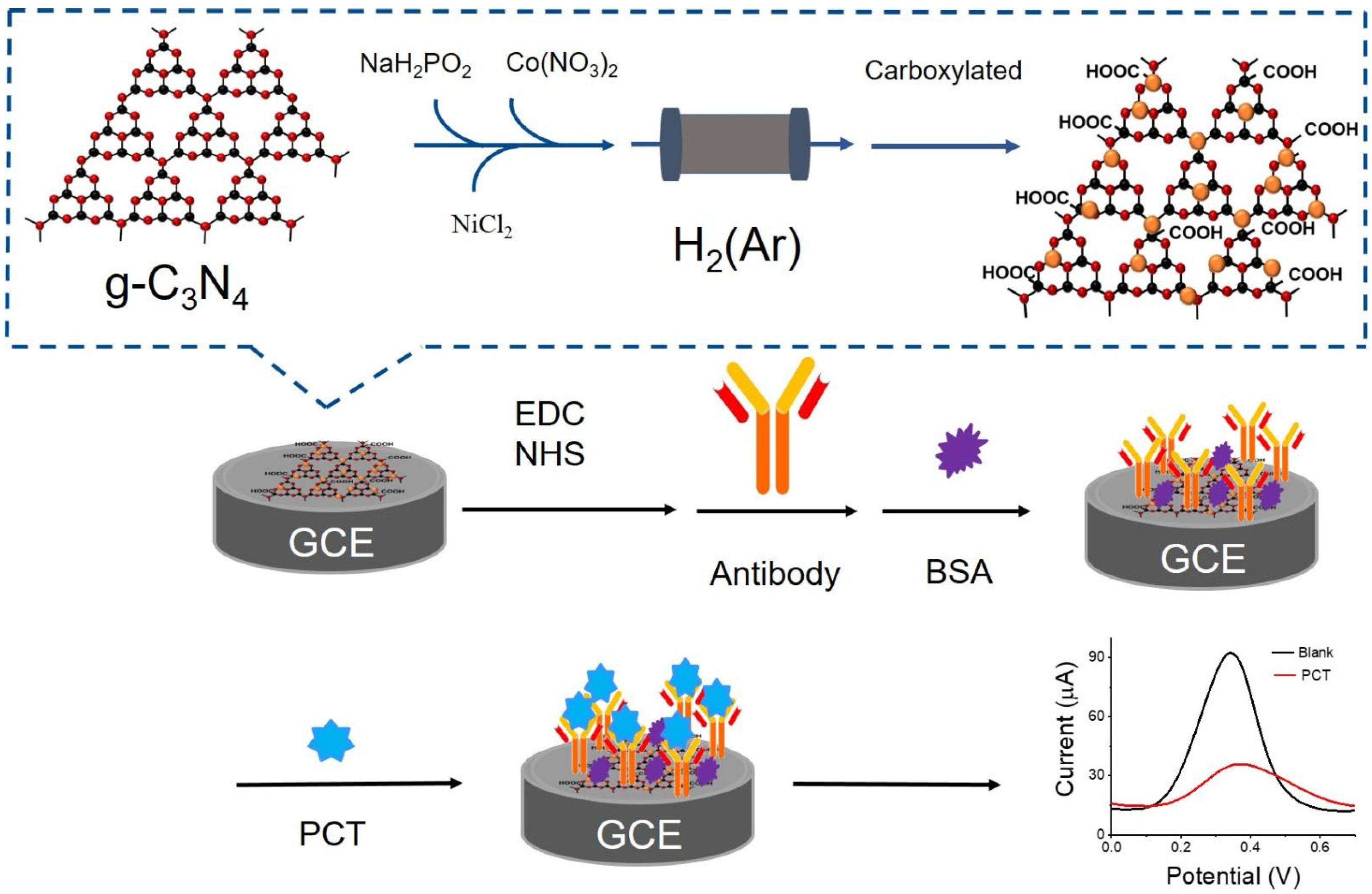
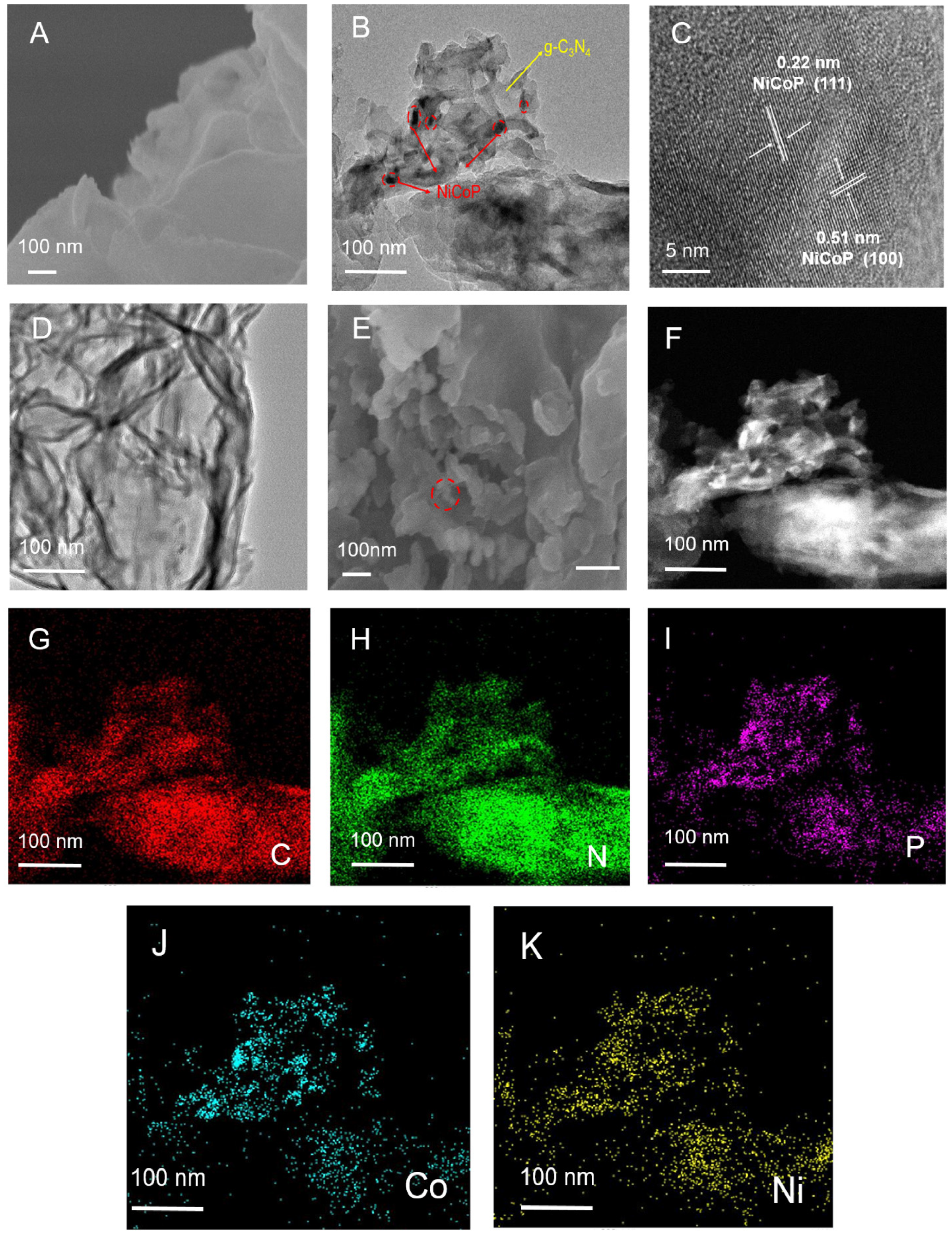
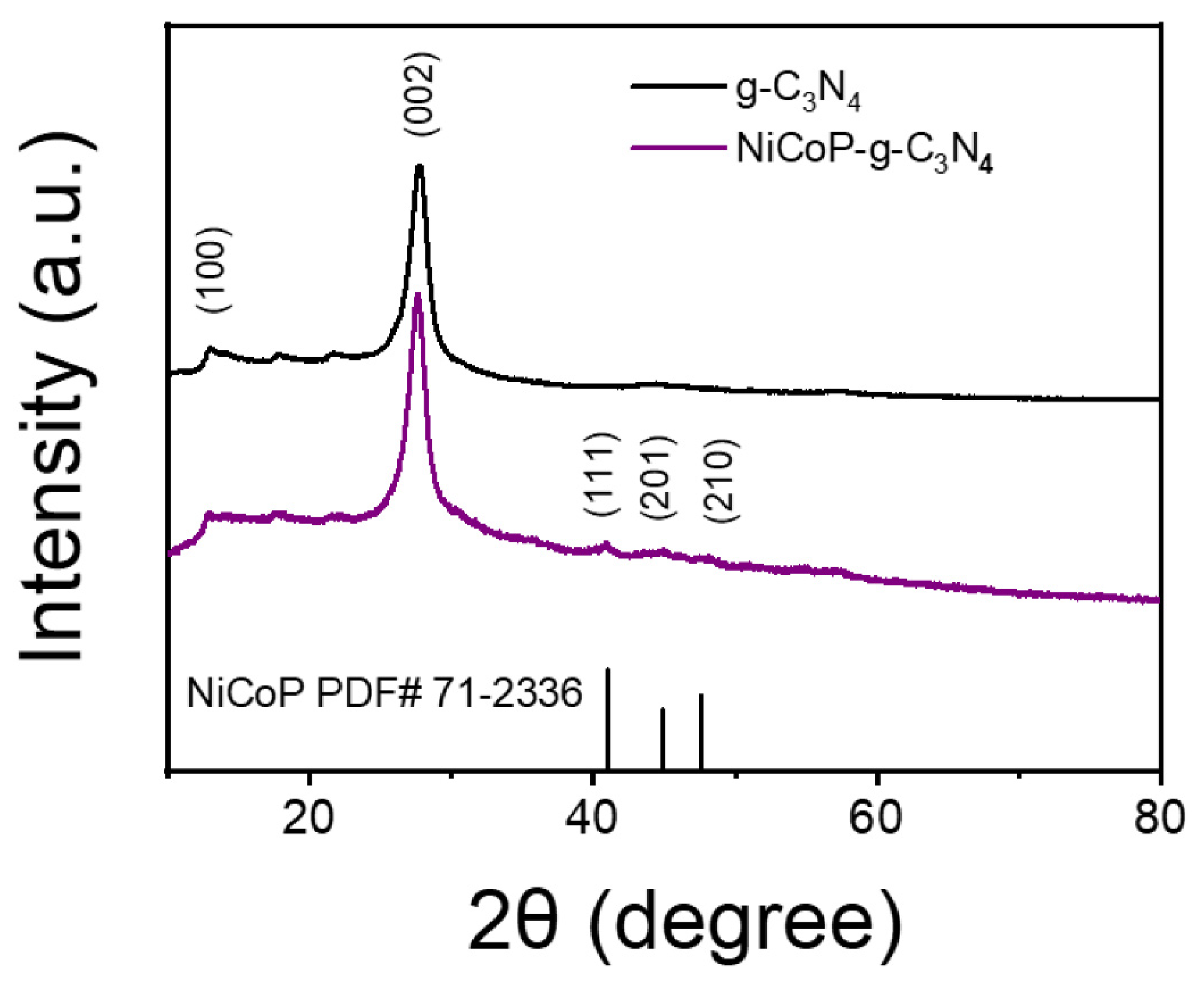


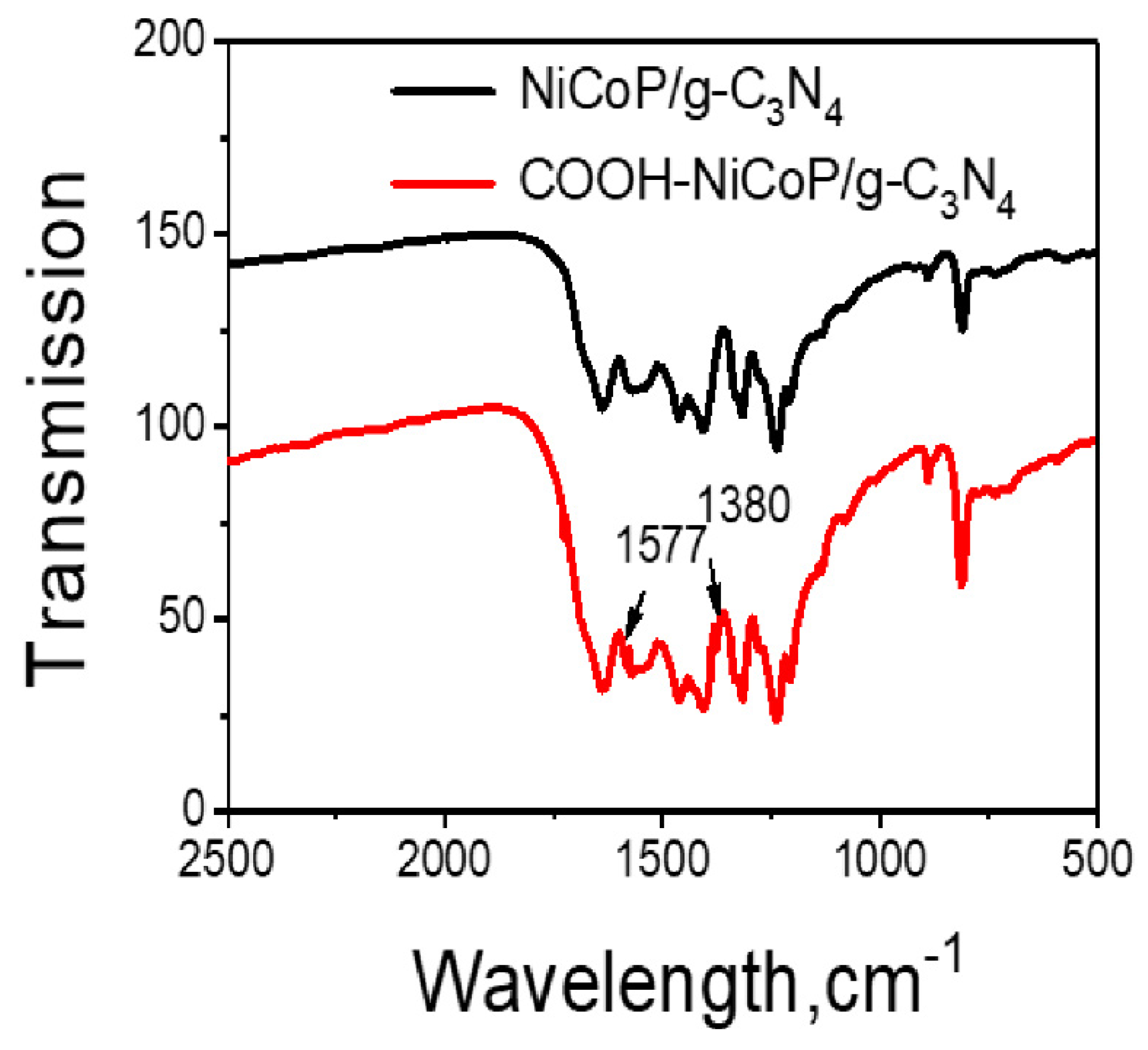
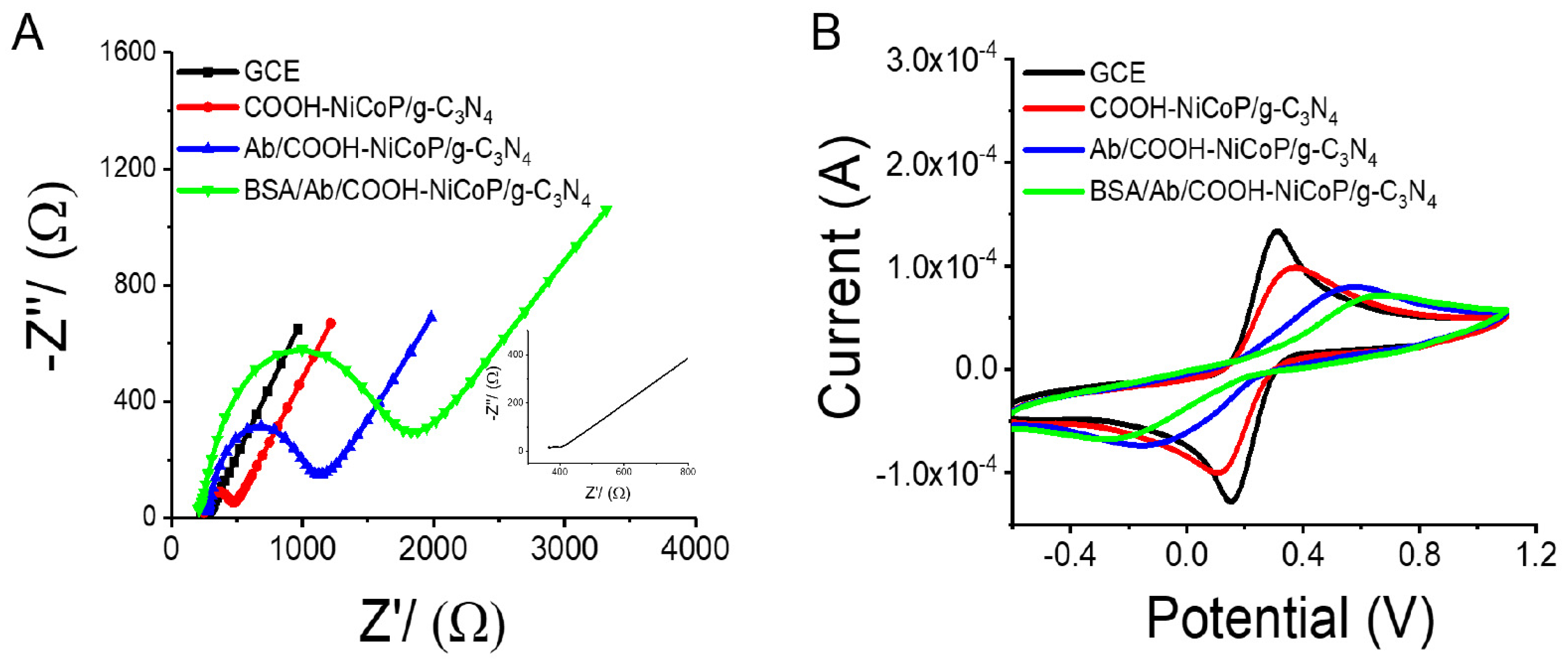
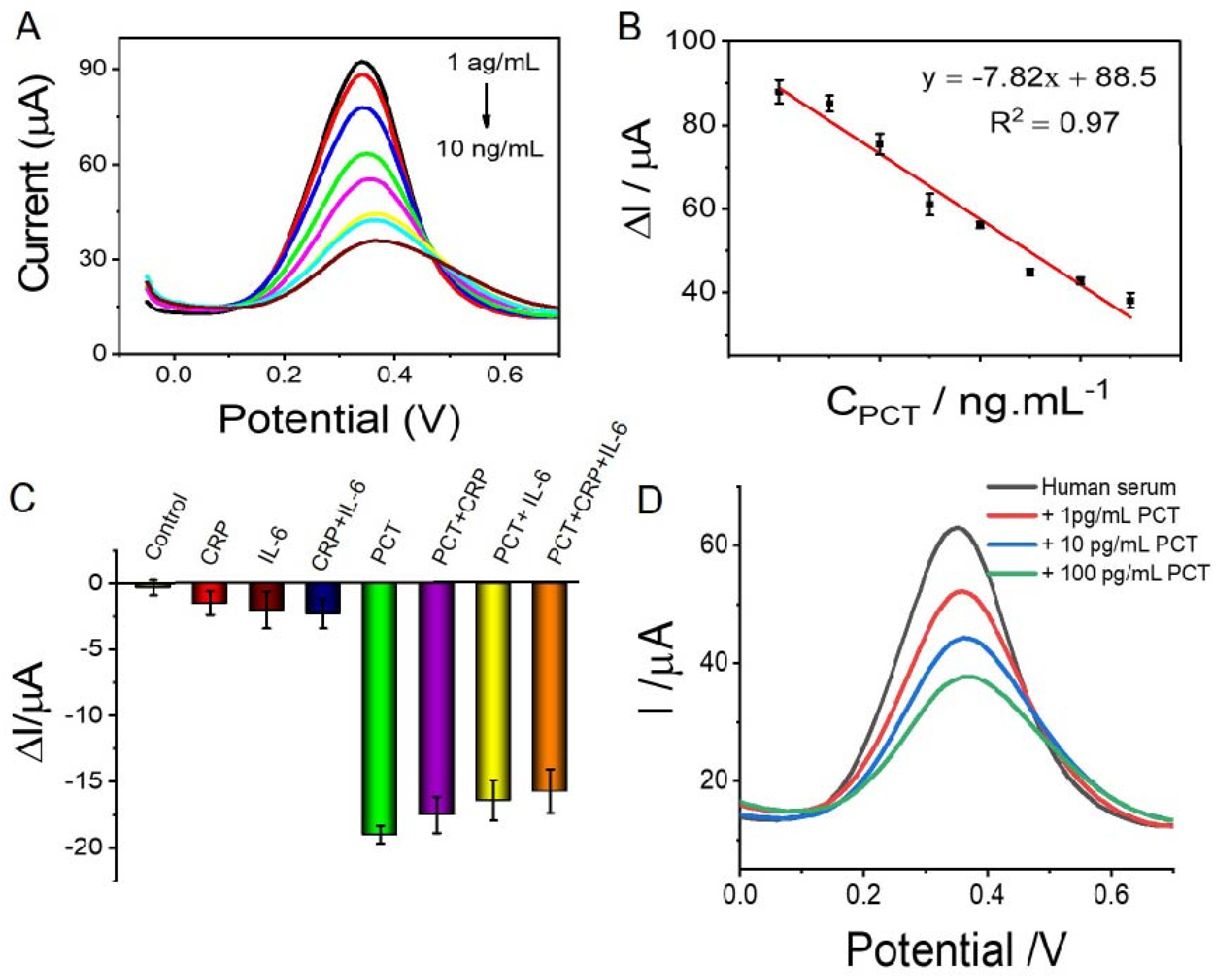
| Method | Linear Range | LOD | Refs. |
|---|---|---|---|
| Electrochemical | 0.0001 to 100 ng/mL | 0.11 pg/mL | [17] |
| Dynamic light scattering (DLS) | 0.035 to 250 pg/mL | 0.03 pg/mL | [48] |
| Chemiluminescence immunoassay | 0.044 to 100 ng/mL | 0.044 ng/mL | [49] |
| Electrochemical immunoassay | 0.005 to 50 ng/mL | 1.67 pg/mL | [50] |
| Immunochromatographic assay | 0.49 to 13.90 ng/mL | 0.1 ng/mL | [51] |
| Electrochemical immunosensor | 0.05 to 90 pg/mL | 0.014 pg/mL | [52] |
| SPR biosensors | 25 to 1000 ng/mL | 30 ng/mL | [53] |
| Photoelectrochemical immunoassay | 0.1 pg/mL to 50 ng/mL | 0.03 pg/mL | [54] |
| Enzyme-free immunosensor | 0.25 to 250 ng/mL | 0.022 ng/mL | [55] |
| Electrochemiluminescence | 0.014 pg/mL to 40 ng/mL | 3.4 fg/mL | [1] |
| Electrochemical immunosensor | 1 ag/mL to 10 ng/mL | 0.6 ag/mL | This work |
| Samples | Added (pg/mL) | Found (pg/mL) | Recovery (%) | RSD (%) * |
|---|---|---|---|---|
| 1 | 1 | 0.93 | 93 | 2.36 |
| 2 | 10 | 9.67 | 96.7 | 1.54 |
| 3 | 100 | 101.2 | 101.2 | 3.15 |
Disclaimer/Publisher’s Note: The statements, opinions and data contained in all publications are solely those of the individual author(s) and contributor(s) and not of MDPI and/or the editor(s). MDPI and/or the editor(s) disclaim responsibility for any injury to people or property resulting from any ideas, methods, instructions or products referred to in the content. |
© 2023 by the authors. Licensee MDPI, Basel, Switzerland. This article is an open access article distributed under the terms and conditions of the Creative Commons Attribution (CC BY) license (https://creativecommons.org/licenses/by/4.0/).
Share and Cite
Chen, F.; Bao, L.; Zhang, Y.; Wang, R.; Liu, J.; Hai, W.; Liu, Y. NiCoP/g-C3N4 Nanocomposites-Based Electrochemical Immunosensor for Sensitive Detection of Procalcitonin. Sensors 2023, 23, 4348. https://doi.org/10.3390/s23094348
Chen F, Bao L, Zhang Y, Wang R, Liu J, Hai W, Liu Y. NiCoP/g-C3N4 Nanocomposites-Based Electrochemical Immunosensor for Sensitive Detection of Procalcitonin. Sensors. 2023; 23(9):4348. https://doi.org/10.3390/s23094348
Chicago/Turabian StyleChen, Furong, Layue Bao, Ying Zhang, Ruili Wang, Jinghai Liu, Wenfeng Hai, and Yushuang Liu. 2023. "NiCoP/g-C3N4 Nanocomposites-Based Electrochemical Immunosensor for Sensitive Detection of Procalcitonin" Sensors 23, no. 9: 4348. https://doi.org/10.3390/s23094348
APA StyleChen, F., Bao, L., Zhang, Y., Wang, R., Liu, J., Hai, W., & Liu, Y. (2023). NiCoP/g-C3N4 Nanocomposites-Based Electrochemical Immunosensor for Sensitive Detection of Procalcitonin. Sensors, 23(9), 4348. https://doi.org/10.3390/s23094348





